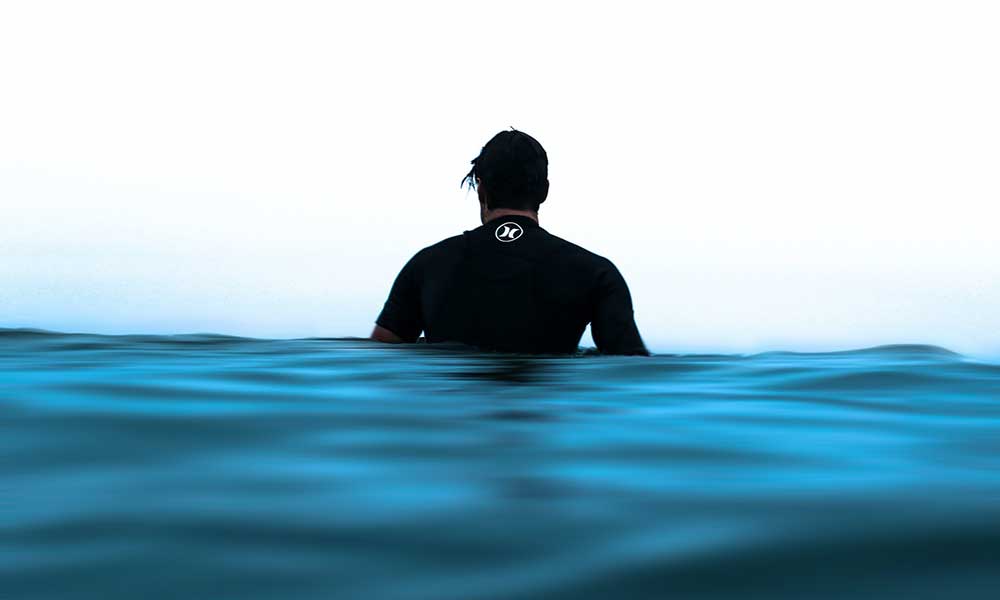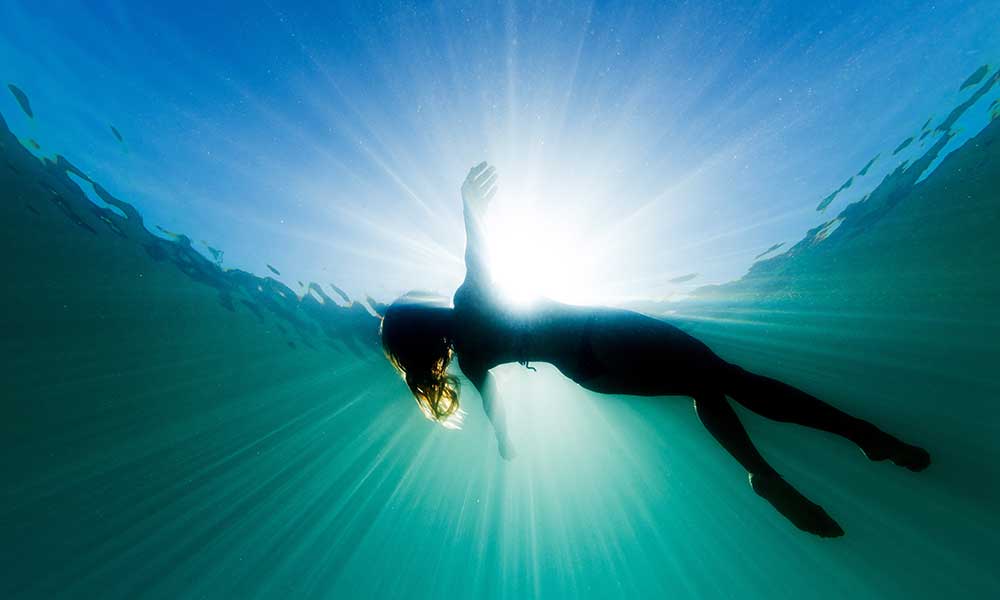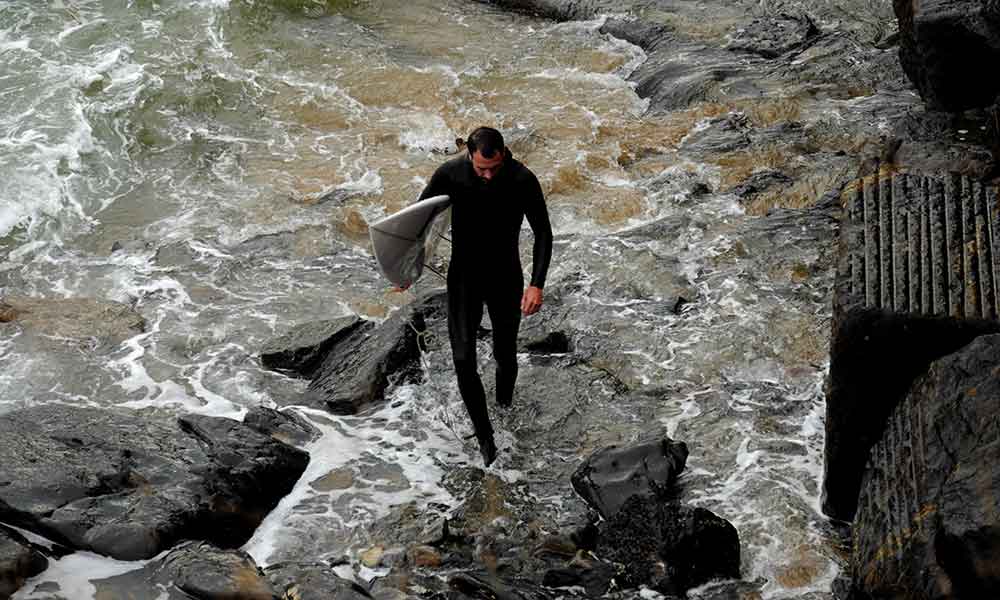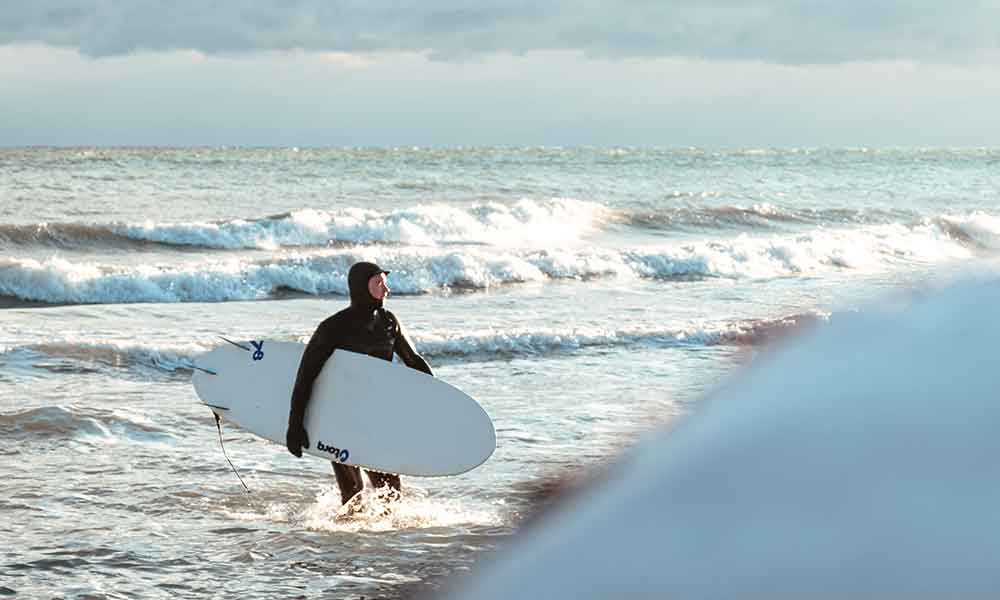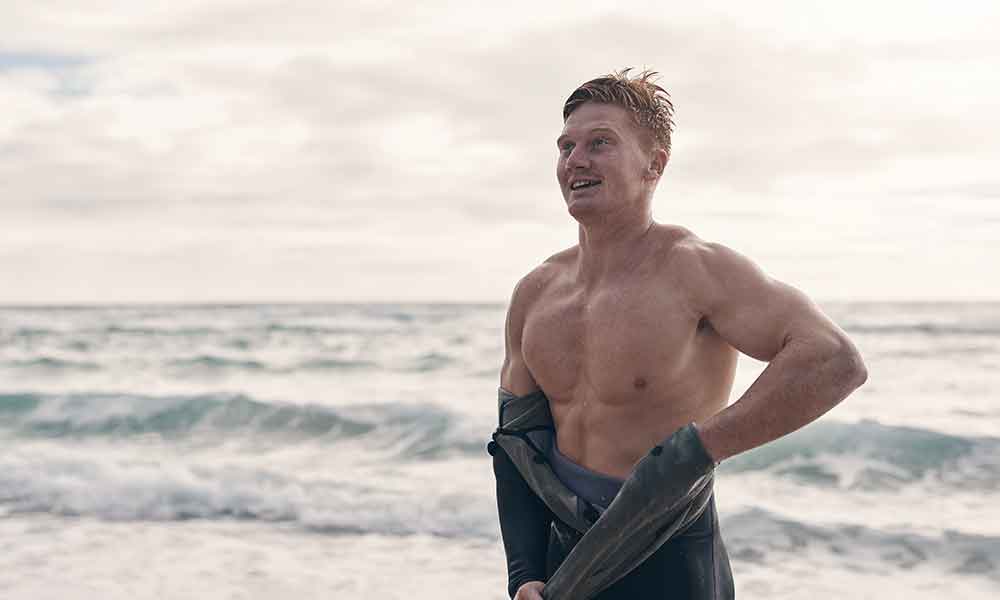A wetsuit is one of the most important items of clothing that you can own as a surfer, swimmer, and snorkeler.
But with so many different wetsuit types, materials, and sizes, how do you know which one to buy?
In the following guide, we’ll look at the types of wetsuits, as well as the materials, seams, stitching, accessories, and more.
What Are the Different Types of Wetsuits?
Wetsuits are not one-size and one-shape-fits-all.
There are many different types of wetsuits and they all serve a unique purpose.
Hooded Full Wetsuits
A lot of your body heat is lost through your head, and no one likes cold ears!
The full hooded wetsuit is just as snug and cozy as it sounds. It covers the entire body and even includes a hood for your head.
With complete arm and leg coverage, a full hooded neoprene wetsuit is ideal for cold water surfing.
They can cost a little more than some of the other wetsuit types, but you’ll be glad for the added insulation when you’re paddling in ice-cold water.
Full Wetsuits
The full wetsuit covers your entire body, but it doesn’t include a hood for your head.
These wetsuits are best for when the water temperature drops and you need complete coverage but aren’t comfortable wearing a hood.
Wetsuit hoods are not like hooded sweatsuits. You won’t look like the Grim Reaper as you’re carving the wave and so it won’t restrict your peripheral vision.
However, some people prefer full wetsuits without hoods.
Long Johns / Janes
The long john wetsuit (male) and long jane wetsuit (female) is basically a full wetsuit that doesn’t cover the arms.
It’s warm, but the fact that it’s sleeveless means your arms will be exposed when paddling.
Wetsuits are stretchable and comfortable, and so paddling shouldn’t be an issue even with complete arm coverage.
However, some people feel a little restricted in sleeves.
Short Johns / Janes
The short john wetsuit (men) and short jane wetsuit (women) provides minimal leg coverage and is completely sleeveless.
If you just need a thin layer of protection that will support your core body temperature and protect against rashes/sunshine without too much coverage, short johns and janes are ideal.
Shorty Wetsuit (Spring Suit)
The shorty wetsuit, also known as the spring wetsuit, is a short-legged suit made for warmer waters.
It provides some protection without covering all of your body and so it’s ideal for spring.
Wetsuit Tops
A wetsuit top provides some neoprene protection for the upper body but doesn’t cover the lower body.
The wetsuit jacket, for instance, provides torso and arm protection, and includes a zip through the middle.
Alternatively, you can purchase a wetsuit vest.
It’s sleeveless, but it will provide some modest upper-body coverage and will also act as a rash guard.
Bottom (Neoprene Shorts)
Neoprene bottoms are available with long legs and short legs.
As with wetsuit jackets and wetsuit vests, they are single pieces that can be worn on their own or with other apparel.
Sexy Wetsuits
The term “sexy wetsuit” seems to be getting a lot more coverage these days.
It’s basically just a wetsuit (almost exclusively for women) that is designed with more of a focus on aesthetics.
If you’re buying one of these wetsuits, pay attention to the coverage, thickness, and quality.
It doesn’t matter how good it looks—a wetsuit should be practical.
There’s nothing sexy about turning blue and shivering your way to an early grave!
Rash Guard
A rash guard is not a type of wetsuit and is actually a shirt that covers the upper body and is designed to protect against rashes and chafing.
If you’re paddling on a waxed board, a rash guard will ensure that you’re not red raw by the end of the day.
And as surfers are three times more likely to contract skin cancer, the added UV protection is a huge bonus.
What Does a 4/3 Wetsuit Mean?
The 4/3 refers to the wetsuit thickness.
The 4 is “4 mm” and is the thickness around the torso area. The 3 is “3mm” and refers to the leg thickness. There are thicker and thinner options available, as well.
Wetsuit Thickness: Do I Need a 4/3 or 3/2 Wetsuit?
It all depends on the water temperature, as well as your personal preference and how well you tolerate cold weather.
If the weather is 52 degrees or less, you should look for a 6/5/4 wetsuit with a hood. The 4/3 option begins to make sense in temperatures of between 53 and 63 degrees while a 3/2 is better for anything warmer.
What Are the Different Types of Wetsuit Materials?
Most wetsuits are made from neoprene, but wetsuit materials can vary.
As concerns are increasingly raised about the environmental impact of neoprene wetsuits, newer and more varied materials are hitting the market.
What Is Neoprene?
Before we look at specific wetsuit materials, it’s important to know what neoprene actually is.
Neoprene is a synthetic rubber that’s also known as polychloroprene.
It was invented back in 1930 and is commonly used in wetsuits due to its strength, durability, water resistance, stretchability, and insulation.
In that sense, it seems like the perfect material, but the manufacturing process is harmful to the environment and produces known carcinogens.
Nylon-Lined Neoprene
In the early days of neoprene wetsuits, people would use talcum powder to peel their wetsuits away from their wet skins.
These days, a nylon fabric is often added to the lining, making for a more comfortable neoprene wetsuit, as well as one that is easy to remove.
Smooth Skin Neoprene
Smooth skin neoprene is often added to neoprene wetsuits to repel wind and water while retaining a lot of heat.
This material is also used in the construction of surfing accessories like wetsuit booties.
The issue with smooth skin neoprene is that it’s not very durable.
Air Neoprene / Ariaprene
In an air neoprene wetsuit, a pocket is created between layers of neoprene and this provides some additional insulation.
These wetsuits are usually more expensive, but the result is a thin and warm suit.
Yulex / Natural Rubber
Wetsuit neoprene is a serious problem for the environment and as surfers are usually environmentally-friendly, many are rejecting this fabric in favor of more natural and sustainable options.
Natural rubber is a great example.
Also known as “Yulex” by Patagonia, natural rubber is an effective, sustainable, and comfortable wetsuit material.
You can expect to pay a little more for this wetsuit material, but at least you know you’ll be doing your bit for the environment.
Yamamoto Neoprene
Yamamoto is a type of closed cell neoprene that is produced from limestone and not oil, making it an eco-friendlier option.
What Is a Wetsuit Lining?
The lining on a wetsuit is used to strengthen the neoprene, provide comfort, and make it easier to get in and out of the wetsuit.
Wetsuit linings are often made from knitted synthetic materials like polyester and nylon, as well as a material like spandex designed to make the lining more flexible.
Considerations for Wetsuit Stitching, Seals, and Seams
Cold water suits need quality stitching to keep the cold and water out.
It should go without saying, and that’s why the seams are just as important as the material.
Wetsuits are created by stitching multiple panels together. The idea is that there should be no gaps and no compromises.
However, this can create some issues with the seams, including:
- Limited Flexibility: Modern wetsuits are very flexible, but they lose that flexibility around the seams. To counteract this issue, a high-quality wetsuit won’t have any seams around key areas such as the underarms and shoulders.
- Leaking: After the zip, the seams are the area most likely to leak. If your wetsuit springs a leak, there’s a good chance that you’ll have a faulty seam somewhere.
- Chafing/Rubbing: The more seams there are, the more durable the wetsuit will be. However, a greater number of seams will also make for a more uncomfortable suit, one that may chafe and rub.
Seals and Stitching Types
The comfort level, durability, flexibility, and even the cost of a wetsuit can be altered by the type of stitching/seal used, including:
- Overlock Stitching: A form of stitching that you’ll also find on your everyday athletic wear. The panels are rolled inwards and stitched together, creating an internal bulge that can chafe. This is a simple and cheap type of stitch and it’s one you’ll find on many low-cost wetsuits and surf suits.
- Flatlock Stitching: A flexible yet durable stitching option whereby the panels are overlaid and then connected. The only issue with this method is that it reduces water resistance. As a result, it’s usually reserved for summer surf suits.
- Blindstitch Stitching: The panels are glued and stitched on the inside, providing flexibility and durability without jeopardizing the water resistance.
- Glued Seams: If a wetsuit has glued seams, it means that the panels have been glued together before being stitched.
- Taped Seams: Tape is added to the inside of the suit to strengthen key areas and protect against water and damage.
- Welded Seals: Liquid rubber (including natural and synthetic rubber) is placed over the seams to create a watertight seal.
How Do I Choose the Right Wetsuit Seam?
It depends on what you’re looking for, and whether you will be using your suit in cold water or warm water.
A greater number of seams should provide you with a wetsuit that fits better and allows for the use of more panels.
If the highest quality neoprene is used, you’ll have a very warm and protective suit on your hands.
However, it won’t be as flexible and unless the seams have been sealed and protected, it may chafe and let in water.
If there are fewer seams, there will be less risk of breaking and chafing. However, it won’t fit as well.
Check out the different wetsuit manufacturers and their methods.
Pay attention to the thickness, flexibility, and material, and make sure you check the reviews to learn what people are saying about how comfortable and strong it is.
Types of Wetsuit Accessories
Whether you’re surfing, scuba diving, or cold water swimming, you can improve your insulation and protection with a few additional accessories, including:
Wetsuit Boots
Also known as wetsuit booties, these accessories can cover your feet in the water.
They’ll stay warm and you won’t need to worry about sharp rocks and coral.
Make sure you always wear your booties under your wetsuit and not the other way around, otherwise, the water will fill your boots.
Wetsuit Gloves
Wetsuit gloves are usually thin, warm, and strong.
They are available in several thicknesses and are produced by many major surfing brands and wetsuit manufacturers.
Wetsuit Hoods
A wetsuit hood will protect your ears against cold water and wind, preventing heat from escaping.
You can buy wetsuit hoods separately or look for a full hooded wetsuit, in which case the hood will be attached.

